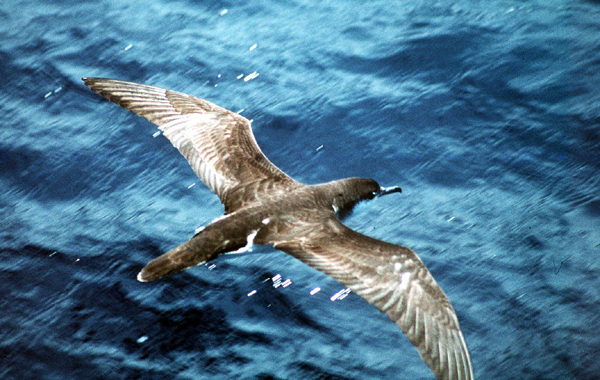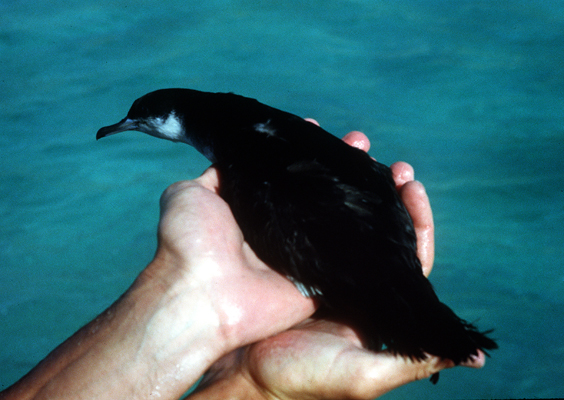|
Audubon’s Shearwater Puffinus lherminieri Pampero de Audubon, |
 |
|
Photo: G. Beaton
|
|
IDENTIFICATION: A medium-sized seabird, with a dark brown back, white undersides, and a long, hooked bill. Length: 27-33 cm.; weight: 150-230 g.; wingspan: 64-74 cm. VOICE: Generally silent at sea, except when squabbling over food. Males and females have quite different vocalizations at the breeding colonies. Males have "clear" voices, and females have "harsh, scratchy" voices. Shearwater pairs are often heard duetting from their nest, but the function of these duets is not known. Audio 3 (W. Mackin). HABITAT: Open ocean; inshore waters close to its breeding colonies on rocky islands. HABITS: Flies with rapid, shallow wingbeats, interspersed with periods of gliding on stiff wings. Shearwaters are relatives of the albatross, and have long, pointed wings that allow them to maneuver in light ocean breezes. This species catches fish, squid and crustaceans by grabbing prey from the surface, or by pursuit diving. In pursuit diving, the shearwater settles on the ocean surface with its head under water; when it spies prey, it dives shallowly in pursuit, using its wings to propel and steer it under water. It often travels in small flocks, and sometimes follows fishing boats. Audubonís Shearwater nests in loose colonies on rocky islands, which it visits only at night, presumably to hide its movements from predators. It nests in a rock crevice or soil burrow, and lays one egg. The incubation period is 49-51 days. Chicks are brooded for the first 3-7 days and fledge 62-75 days after hatching. This species does not breed until about eight years of age. STATUS AND CONSERVATION: Audubonís Shearwater is uncommon near islets where it nests off of Culebra, but only during the breeding season. Nesting colonies in many parts of the world are threatened by introduced mammals and by human egg collecting. The West Indian breeding population is estimated at 3,000-5,000 pairs. RANGE: Tropical oceans around the world. TAXONOMY: PROCELLARIIFORMES; PROCELLARIIDAE |
|
 |
|
|
Photo: J. Saliva*
|
|
References Bent, A.C. 1922. Life histories of North American petrels and pelicans and their allies. Smithsonian Instit. U.S. National Museum Bull. 121. (Reprinted by Dover Press, NY, 1964). Dammann, A.E. and D.W. Nellis. 1992. A natural history atlas to the cays of the U.S. Virgin Islands. Pineapple Press, Sarasota, FL. del Hoyo, J., A. Elliott, and J. Sargatal, eds. 1992. Handbook of the Birds of the World, Vol. 1. Ostrich to ducks. Lynx Edicions, Barcelona. Erdman, D.S. 1967. Seabirds in relation to game fish schools off Puerto Rico and the Virgin Islands. Carib. J. Sci. 7:78-85. Harrison, P. 1983. Seabirds: an identification guide. Houghton Mifflin, Boston. Harrison, P. 1987. A field guide to seabirds of the world. Stephen Greene Press, Lexington, MA. Lee, D. S. 2000. Status and conservation priorities for Audubon's Shearwater in the West Indies. Pp. 25-30 in Status and conservation of West Indian seabirds (E. A. Schreiber and D. S. Lee, eds.). Soc. Carib. Ornith., Special Pub. No. 1. Mackin, W. A. 2000. A geographic information system for seabird breeding sites in the West Indies. Pp. 174-181 in Status and conservation of West Indian seabirds (E. A. Schreiber and D. S. Lee, eds.). Soc. Carib. Ornith., Special Pub. No. 1. Platania, S. P., G. S. Grant, and D. S. Lee. 1986. Core temperatures of non-nesting Western Atlantic seabirds. Brimleyana 12:13-18. Raffaele, H.A. 1989. A guide to the birds of Puerto Rico and the Virgin Islands. Princeton. Raffaele, H.A. 1989. Una guía a las aves de Puerto Rico y las Islas Vírgenes. Publishing Resources, Inc., Santurce, PR. Raffaele, H.A., J.W. Wiley, O.H. Garrido, A.R. Keith, and J.I. Raffaele. 1998. Guide to the birds of the West Indies. Princeton. Schreiber, E. A. and D. S. Lee. 2000. West Indian seabirds: a disappearing natural resource. Pp. 1-10 in Status and conservation of West Indian seabirds (E. A. Schreiber and D. S. Lee, eds.). Soc. Carib. Ornith., Special Pub. No. 1. Schreiber, E. A. 2000. Action plan for conservation of West Indian seabirds. Pp. 182-191 in Status and conservation of West Indian seabirds (E. A. Schreiber and D. S. Lee, eds.). Soc. Carib. Ornith., Special Pub. No. 1. Wiley, J. W. 2000. A bibliography of seabirds in the West Indies. Pp. 192-225 in Status and conservation of West Indian seabirds (E. A. Schreiber and D. S. Lee, eds.). Soc. Carib. Ornith., Special Pub. No. 1. Audubon's Shearwater, Spanish text Next related species in taxonomic order Previous related species in taxonomic order |